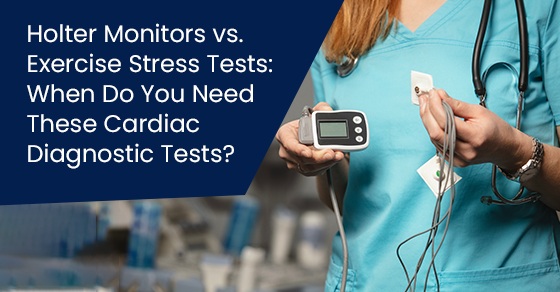Holter Monitors vs. Exercise Stress Tests: When Do You Need These Cardiac Diagnostic Tests?

Holter monitor tests and exercise stress tests are diagnostic tools used for different purposes. One is a 24-hour device that detects irregular heartbeats or finds things that an electrocardiogram can miss, while the other determines how well the heart responds under physical stress. While both monitor heart activity, they are used for very different purposes.
24-Hour Holter Monitor (HM)
Holter monitors use ECG (electrocardiogram) readings, which are taken while an individual performs their regular daily routine over a pre-established time frame, typically lasting more than 24 hours.
Why is it used?
The Holter monitor test is a useful diagnostic tool for people experiencing intermittent or recurring symptoms (palpitations, chest pain, or dizziness). Holter monitors detect arrhythmias (irregular heartbeat) and can be done if an electrocardiogram isn’t providing enough detail about the condition of your heart.
Why is it done?
It may be necessary for the following reasons:
- You are fainting from an unknown cause.
- You exhibit symptoms of an irregular heartbeat.
- You have a heart condition, increasing the risk of irregular heartbeats.
- To assess the future risk of heart-related events (thickened heart walls after a heart attack).
- To monitor the effectiveness of a pacemaker.
- To find out how treatment is going for a complex abnormal heart rhythm.
- To determine the heart rate’s speed during the day or check for pauses.
Since changes in the heart’s rhythm and rate can generate these changes, patients are often provided with a diary to record symptoms experienced while wearing the monitor. It enables physicians to compare your symptoms with the recordings to determine if there is a correlation.
However, before we give you an HM, patients can expect to have an electrocardiogram to check the rhythm of their heart. HMs can often locate irregular heartbeats that the ECGs miss.
What Patients Can Expect
Patients can expect to wear a Holter monitor for 24 hours, but it can extend to two days. Self-adhesive electrodes used for monitoring are placed on your chest and are attached to HM wires. These electrodes pick up signals from the heart while transferring them to your portable monitor. Recordings are sent to your physician once the test is completed.
Patient Diary
A patient diary will be given to you during your appointment. You are advised to use it to record symptoms you experience while wearing your monitor. Some examples of activities can include smoking, stress, exercise, sleeping, and intercourse. It involves anything that can affect/elevate your heart rate.
Noteworthy symptoms to record may include:
- Face, arm, neck, and chest pain
- Heart palpitations (heart jumping or pounding)
- Nausea
- Dizziness
- Anxiety
- Shortness of breath
We advise patients to record all symptoms and note the time when they happen.
During your application appointment, we will instruct you on when and how to remove your monitor from your chest. Following these instructions ensures that the monitor isn’t removed too early, which will ensure that you receive a complete test.
The monitor must be returned on the next business day after your application appointment, and it can be dropped off by anyone you choose.
Things to Note About the Holter Monitor Test
While the HM doesn’t interfere with your daily routine, there are a few things we advise patients on:
- Wearing the monitor will not allow you to bathe, swim, or shower. Patients should consider this when booking an appointment to plan their day accordingly.
- Refrain from tampering with your recorder. This includes touching wire connections or removing battery covers.
- Continue taking your prescribed medication.
- Refrain from pulling on electrode wires/leads, and do not disturb the tape holding them in place. Touching them can interfere with recordings and may require repeating the test. If electrodes loosen, secure them using tape. To ensure they do not disconnect or fall off while sleeping, wear a snug-fitting nightgown or T-shirt to bed.
- Heating pads, electric blankets, and electric razors can interfere with recordings. Therefore, please avoid using them when wearing the HM.
- Computers, cell phones, game consoles, etc., will not interfere with your monitor.
Exercise Stress Test
A treadmill test assesses the heart muscle’s response to increased physical exercise within a controlled setting. It evaluates suspected, known, or potential heart issues. Additionally, the test’s results will be used to determine future exercise programs if you are enrolled in one.
A cardiac exercise test monitors the heart’s response to standard physical activity.
Why is the exercise stress test done?
This test is performed to learn:
- Whether the heart is receiving an adequate blood supply.
- How well the heart pumps blood.
- How the heart performs during physical activity compared to others of the same sex and age.
- If symptoms replicate under physical exercise.
Exercise stress tests can identify heart issues, such as those affecting the heart valves or muscles, determine if there is enough blood supply to the heart, and assess the electrical stability of the heart during exercise and while resting.
It also helps health providers determine whether additional testing is needed to confirm a diagnosis or if treatment can lower heart attack risk.
Preparation
We ask that you refrain from taking the following prescriptions on the morning of your test. These include:
- All beta blockers/certain calcium channel blockers
- Acebutolol (Sectral)
- Atenolol (Tenoretic/Tenormin)
- Diltiazem (Cardizem)
- Labetalol (Normodyne)
- Metoprolol (Lopressor)
- Monocor (Bisoprolol)
- Nadolol (Corgrad)
- Pindolol (Visken)
- Propranolol (Inderal)
- Sotolol (Sotacor)
- Timolol (Blocadren)
- Verapamil (Chronovera, Isoptin)
We recommend that patients wear comfortable clothing specifically designed for exercise. Men exercise without a shirt and women are advised to wear short-sleeved, baggy T-shirts or button-closing, loose tops. Ladies, please also wear bras without underwires.
How the Test Is Conducted
Patients use a treadmill for the tests. Self-adhesive electrodes are placed on the chest before beginning. While you are exercising, the workload placed on the heart increases gradually; the incline and speed of the treadmill increase at three-minute intervals. The effect is similar to walking faster up a large hill.
Your blood pressure, pulse, and heart tracing are monitored until you have achieved your age-predicted target heart rate or show symptoms like shortness of breath, tiredness, chest discomfort, or inform us that you cannot continue.
Exercise technicians remain by your side, and your doctor will be in the room and have visual contact with you throughout your procedure. Additionally, trained personnel and emergency equipment are present to deal with any situations that could arise.
Aspire Cardiology Provides Fast, Quality Cardiac Care
At Aspire Cardiology, we are a state-of-the-art cardiology clinic in Markham, Ontario, offering comprehensive consultations and diagnostic services in one convenient location. We strive to provide our patients with excellence and quality in cardiac health services. Our team is certified and trained to provide you with superior, quick access to care when it matters most.
To book your Holter monitoring test, exercise stress test, or for any other cardiac care/assessments, call us at 647-503-3639, contact us online, or email us at admin@aspirecardiology.com.

